Animal Cruelty and the Law in China
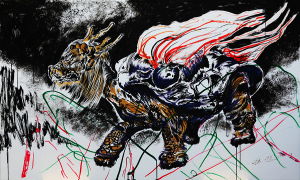
Interview by Richard Marshall.

'I think there is a huge gap between the animals in Chinese people’s imagination and the animals in real life. In the zodiac portrayal, the 12 animals are living beings with feelings, personalities, intelligence and wisdom, but in the real life, the Chinese people have little positive things to say about the zodiac animals such as pigs, hens/roosters, mice/rats, monkeys, snakes and dogs, and most view them with distain and treat them as lifeless things.'
'With an increasingly globalized economy and world, we now have a globalized wildlife crisis. What happens to animals in China or by the Chinese goes beyond the Chinese borders. There are many examples for this. For instance, elephants and rhinos in Africa are on the brink of extinction largely due to the trafficking of their body parts for the Chinese market. There is a direct link between the killing of those animals and the Chinese use of the animal body parts. Less well known are other creatures going extinct also due to Chinese consumption. One recent example is the plight of hehuaque, the common Chinese name for the Yellow-breasted Bunting. In Guangdong Province alone in southern China, an estimated million Yellow-breasted Buntings are eaten each year, and many more millions eaten across China.'
'China has some of the toughest criminal penalties in the world in this area, but unfortunately, there are far too many criminal acts and enterprises that escape punishment and the law has not been effectively enforced or deterred offenders. But law enforcement and criminal sanctions for crimes against animals are poor and problematic, to say the least, around the world, including Western countries where excessive leniency is far too common, a slap on the wrist at best, or offenders are simply not prosecuted, because the victims are non-human animals, not humans.'
'We need another and a wiser and perhaps a more mystical concept of animals. Remote from universal nature and living by complicated artifice, man in civilization surveys the creature through the glass of his knowledge and sees thereby a feather magnified and the whole image in distortion. We patronize them for their incompleteness, for their tragic fate for having taken form so far below ourselves. And therein do we err. For the animal shall not be measured by man. In a world older and more complete than ours, they move finished and complete, gifted with the extension of the senses we have lost or never attained, living by voices we shall never hear. They are not brethren, they are not underlings: they are other nations, caught with ourselves in the net of life and time, fellow prisoners of the splendourand travail of the earth (Beston, 1929)'
'If we compare English and Chinese, legal English is such a long established specialist language that a native English speaker requires a legal education just to understand the legal jargon. In contrast, the language used in Chinese law is very ordinary, almost banal and extraordinarily plain.'
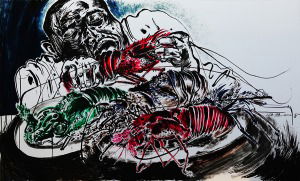
[Art: Sun Xun]
Deborah Cao is a philosophically inclined thinker working in the areas of animal law, Chinese animal welfare, farm animal welfare, animal ethics and Chinese legal language. Here she discusses animal welfare and legal protections in China, the impact of globalisation on animal welfare in China and beyond, the history of Chinese attitudes and practices towards animals, the impact of other cultures on Chinese attitudes, what the law can and needs to do regarding animal cruelty, extending the law so that animals become seen as legal victims of human harm and expanding the definition of crimes against wildlife to include harms done to them both legally and illegally, and foundational questions regarding law including language and translation.
3:16: What made you become a philosopher?
Deborah Cao: Thanks for the question, but I am not really a philosopher. I do write about ethical issues, applied ethics relating to animals and human animal relations and animal law. I also write about philosophical matters relating to Chinese legal language, culture and law.
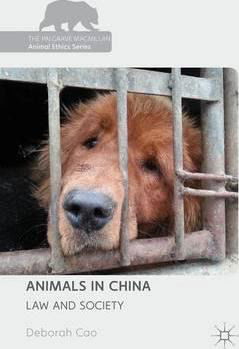
3:16: You’ve looked at Chinese law and animals. Animal suffering is not something the Chinese think about a lot and there’s no protection for animals even when domesticated, which is odd isn’t it. Can you first say something about how odd it is: is China unique in this respect, and why isn’t Chinese culture and law awake to animal suffering? Why is such an advanced and sophisticated society which philosophically doesn’t make much of the distinction between human and other animals two hundred years behind the rest of the world in this matter? Is it because instrumentalism dominates thinking about animals there? Is it that Chinese culture doesn’t have taboos around eating anything living?
DC: Animals and animal symbols are very important in Chinese culture. People around the world now get to know and join in the lunar Chinese New Year celebrations each year, celebrated around the world now, not just in China, and the familiar Chinese zodiac animals, the 12 animals cycle, real and imagined animals. However, I think there is a huge gap between the animals in Chinese people’s imagination and the animals in real life. In the zodiac portrayal, the 12 animals are living beings with feelings, personalities, intelligence and wisdom, but in the real life, the Chinese people have little positive things to say about the zodiac animals such as pigs, hens/roosters, mice/rats, monkeys, snakes and dogs, and most view them with distain and treat them as lifeless things. The popular complimentary discourses about the zodiac animals are detached from Chinese reality.
As we know, animals have always been important to Chinese culture. When one travels in China, one sees animals everywhere, but mostly dead ones - on dinner tables and in restaurants, as decorative pieces in people’s homes and in Chinese medicine. Beautiful animal statues and carvings are found in old palaces, on gravestones, as symbols of cities, and as art of carvings made from ivory. Chinese people would know a person’s age by simply knowing the person’s animal symbol. Women choose to have children and give birth in a certain period just to have a particular animal sign for their offspring. As I wrote before, the Chinese love animals, but they love them to death, literally, especially love to eat them, to kill them, to take them in medicine, driving some animal species to the brink of extinction. Animals of all kinds are resources to be exploited, tools to be used or food to be eaten. The instrumental approach has always dominated Chinese thinking and acting towards animals.
Despite the enormous destruction and suffering inflicted on animals, animal suffering had not been a concern in Chinese culture until recently. Animal suffering is still not a topic taught in schools in China or discussed as an intellectual matter and is not an issue of concern in law. The few people who write about animal suffering or assist animals are often dismissed as chi bao le cheng de(having eaten too much food with nothing better to do) or worse.People just ignore or simply do not think about or are not bothered by animal pains and suffering caused by humans. I was one of the oblivious Chinese, born and educated in China, until my husband, Larry, who originally came from New York, asked me to contemplate the pain that animals might have experienced in Chinese cooking while we were living in China many years ago. It was the first time I ever considered the question of animal suffering, and how much pain they must be enduring before being eaten, something we Chinese just ignore, without a blink of an eye or the slightest concern. Never ever had the matter been raised in our education or upbringing. My subsequent discussions with Larry and his encouragement prompted me to not just think but also do something about it, in trying to make other Chinese consider the pain we are causing to those living and breathing creatures, and also trying to help animals in need of help in China and elsewhere. So, that’s what I have been doing over the last ten years or so.
Speaking of food taboos, two most important cultural influences over my adult life have been the Chinese culture that I was born into, and the Jewish culture which is my husband Larry’s heritage. These two ancient cultures have very different practices towards food and animals associated with food. The Chinese would basically eat any animals, and it is mainly up to an individual to decide. It was once said that the only animal the Chinese do not seem to eat is panda, but that turned out to be wrong. A few years ago, people in China were caught and prosecuted for killing and intending to sell panda flesh. As for the Jewish culture, there are quite a number of dietary restrictions or taboos concerning meat and animal products. It is partly for human health and religious reasons, and also out of concern for animals. Judaism teaches that humans must avoid causing pain to any living creature, and such moral teaching is incorporated into the dietary practices and daily life of the Jewish people for thousands of years. This impresses me deeply given my Chinese cultural background and reminds me almost every day that such concerns and practices are sorely lacking for the Chinese. I love both cultures, and I have learned a great deal from the Jewish culture concerning respect for life and for animals, among other things.
3:16: Can you say something about the scale of the problem in China so we can see why this is such an important topic and not a minor thing, and does Globalisation have a role in the scale?
DC: For the last two decades, the world has seen the rise of China. I suggested earlier that with China’s rise has come the fall, retreat, and demise of some animals and animal species. With an increasingly globalized economy and world, we now have a globalized wildlife crisis. What happens to animals in China or by the Chinese goes beyond the Chinese borders. There are many examples for this. For instance, elephants and rhinos in Africa are on the brink of extinction largely due to the trafficking of their body parts for the Chinese market. There is a direct link between the killing of those animals and the Chinese use of the animal body parts. Less well known are other creatures going extinct also due to Chinese consumption. One recent example is the plight of hehuaque, the common Chinese name for the Yellow-breasted Bunting. In Guangdong Province alone in southern China, an estimated million Yellow-breasted Buntings are eaten each year, and many more millions eaten across China. Previously, the birds were superabundant for large parts of their range in Europe and Asia, but their population fell drastically in the last two decades. China outlawed the trade of the birds in 1997, but ongoing illegal trade along the entire Chinese flyway has continued. The bunting has recently been upgraded to a status of Critically Endangered by the International Union for the Conservation of Nature (IUCN), due to heavy hunting in China as the birds fly over from Europe to China during winter migration. As a newspaper in the U.K. puts it, “one of Britain’s most beautiful birds is destined to become extinct after becoming a popular Chinese snack.”
Manta rays are another animal who in recent times have become a target of the Chinese eating, and are now endangered. Still another case, pangolins have become the most trafficked mammal in the world, all because they are used in Traditional Chinese Medicine or as a health tonic.The list goes on…. In all these cases of Chinese consumption of wild animals, the animals are poached to the brink of extinction largely due to the demand for their body parts for eating or the alleged magic health benefits, none of which have any scientific evidence in modern medical science, hyped, or fabricated, or just plainly wrong. I have written more extensively about these in my book Animals in China:Law and Society(2015) and also in a recent paper – ‘Wild Game Changer: Regarding Animals in Chinese Culture’, published in late 2018 in the Harvard Review of Philosophy, if readers are interested.
I also suggested previously that China is a world factory for manufactured animal cruelty and is exporting it. For instance, apart from wildlife trafficking and transnational crimes linking China with Africa and other countries in illegal activities, less well-known are laboratory animals, including non-human primates, bred and sold for research in and outside China. China has become the world’s leading supplier of laboratory animals to companies and research institutions in Western countries. Still another example of globalized animal cruelty is China’s growing fur industry, the breeding and slaughter of animals to feed the world’s appetite for fur. China is now the world’s leading supplier of furs and fur garments.
Conversely, the inhumane and cruel practices of intensive farming invented and promoted by Western companies have now been introduced to China and other developing countries in the name of modern advanced management practice for efficiency and cost-effectiveness, another instance of globalized animal cruelty.
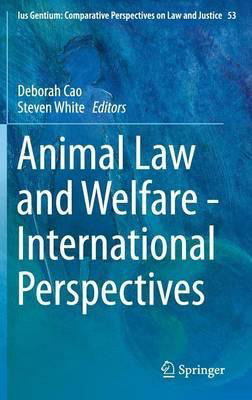
3:16: What’s the relationship between the dominant conceptualisation of animals in China and their actual treatment? How do you explain the radical disconnect between the abstract reverence and concrete cruelty? Is this a case where ideology (treat animals with reverence) isn’t guiding action (treat them abominably)? And does this point to a limitation to purely rational, conceptual, philosophical work in this domain?
DC: As I said earlier, there is a disconnect between the Chinese imagination of animals and actual reality. Interestingly, in traditional Chinese philosophy, there is no essential or strict delineation distinguishing humans and animals in terms of nature in Confucianism, Daoism and other core Chinese traditional thoughts, in contrast to Aristotle and later the dominant Cartesian thinking in the West where humans and animals are perceived as fundamentally different and separate and animals are thought to lack rationality and moral standing. In traditional Chinese philosophy, animals were considered to be an integral part of a larger cosmos rather than creatures conceived as a purely biological species, again in contrast to ancient Greek and Rome thinkers. It was widely accepted in traditional Chinese philosophy that the human world and the natural world are interconnected with the same normative patterns in a continuum, and both humans and non-humans have their own existential value. An interesting quote from Zhuangzi (476–221 BCE), the leading Daoist philosopher, says: Dao is in the ants, in the weeds, in the ruins and in the dung. In the Chinese mapping of the universe, humans are organically connected with rocks, trees and animals, and human life is part of a continuous flow of the vital energy that constitutes the cosmic process, and mountains and rivers and animals as well as humans are legitimate beings in the cosmos.
However, what is said and taught in philosophy does not guarantee the translation of those ideas into action and reality. The Chinese destruction and mistreatment of animals have been going on for thousands of years, not just in modern time. There is a gap between the philosophical teaching about animal-human relations and the actual treatment that animals receive from the Chinese. I suppose there is limit to moral teaching in guiding people’s behaviour. Perhaps humans are hypocritical, saying one thing and doing another. But this is certainly not limited to the Chinese. An American animal legal scholar and animal rights advocate Francione calls such common human phenomenon ‘moral schizophrenia’, that is, say one thing about what we believe and care about animals and do another in our actual behaviour. Many people across different cultures profess their care for animals, but then they do not mind ending their life because the animals are too troublesome or surplus, that is, troublesome to humans and surplus to human needs and comfort.
3:16: What was the situation in imperial China 1.000 years ago? Weren’t domestic animals protected then? Was it the law that helped teach people how to close the gap between thinking about animals and the way they are treated back then, and do you think it can be done again today in contemporary China?
DC: Interestingly, China may be one of the first countries that had legal provisions for working animals. I went through old Chinese imperial law books and found a number of interesting provisions. For instance, the Tang Code of the Tang Dynasty (618-907CE) had provisions on the protection of animals used for various official purposes, including public stables and sacrificial animals. The law concerned the health, overworking, injuring and intentional killing of such animals, mainly horses and cattle. I don’t think we should overinterpret the law as an indication of a primary concern for the animals by the Chinese emperors. Nevertheless, they do indicate is that such animals were regarded as very important and valuable resources and property of the government and the emperors, important enough to be written into law. People in charge of the official animals were held legally responsible for the care and treatment of the animals. Such provisions existed as part of the most important legal codes in imperial China for more than a thousand years are significant and worth reflection, particularly considering the fact that there is no law protecting working animals in China today.
3:16: What is wildlife law in China like at the moment and what is happening regards reform?
DC: There are numerous laws, regulations and directives for wildlife in China, and some of the punishments for wildlife crimes are severe. There are legal provisions found in the Chinese Constitution, laws, regulations, and binding interpretations and opinions from the court and relevant authorities. Important ones include the Wildlife Protection Law, and Criminal Law, and Environmental Protection Law. China is also a party to a number of international treaties and bilateral treaties pertinent to wildlife, including the Convention on International Trade in Endangered Species of Wild Fauna and Flora (CITES), Biodiversity Convention, among others. In the newly amended Wildlife Protection Law, a provision on the prohibition of cruelty to wildlife was added a couple of years ago. However, unfortunately, endangered species or wildlife in general are still regarded as resources for utilization and exploitation for human benefits, and such a guiding principle has not been altered.
One thing I would like to point out is that China has some of the toughest or perhaps the toughest criminal sanctions against wildlife crimes in the world. I studied and documented many court cases concerning wildlife crimes in recent year in China in my book Animals in China. There are many cases, especially those involving the smuggling and the illegal sale of elephant ivory, rhino horns, pangolins, where the perpetrators were sentenced to ten or twenty years or life imprisonment. The death penalty was applied to a few wildlife crimes, but not anymore. So, China has some of the toughest criminal penalties in the world in this area, but unfortunately, there are far too many criminal acts and enterprises that escape punishment and the law has not been effectively enforced or deterred offenders. But law enforcement and criminal sanctions for crimes against animals are poor and problematic, to say the least, around the world, including Western countries where excessive leniency is far too common, a slap on the wrist at best, or offenders are simply not prosecuted, because the victims are non-human animals, not humans. Of course, there is the question of achieving a balance in just punishment and deterring offenders and educating the general population.
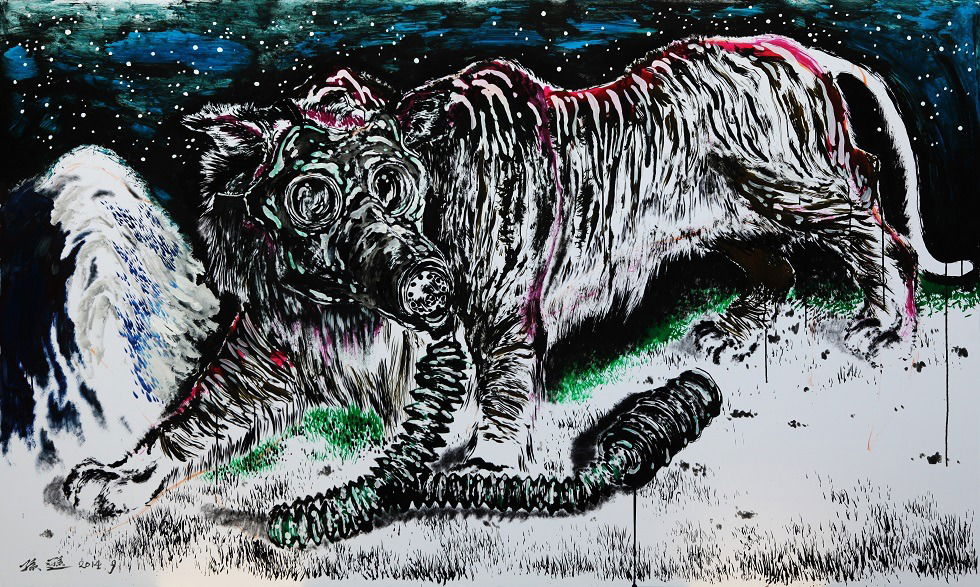
[Art: Sun Xun]
3:16: Do you think increased contact with other societies will put pressure on China to reform their laws and will the growth of a modern sophisticated urban middle class demographic also help this? Are you optimistic?
DC: Yes, certainly. The concepts of animal welfare and animal rights and legal protection of animals have been introduced to China from the West in the past twenty years or so. Because of the contact and interactions between the Chinese and Western societies and people, particularly, the owning of a family cat or dog by increasing number of Chinese households in urban areas have had profound impact on how the Chinese see animals, at least cats and dogs. People who live with cats and dogs can see for themselves and experience how animals feel and live, very much like ourselves, feeling happy, sad and pain, and other emotions. Today, many pet owners, especially young people, are animal rescuers and carers. They donate money and time for homeless animals and help rehome them. They are also active in reporting animal abuse and wildlife crimes. All these give me hope and optimism, as such change of heart and changes in people’s attitudes and behaviour are taking place within a very short period of time in the last decade.
A significant development is the ban and closing down of all ivory manufacturing factories and retail shops in China at the end of 2017 by the Chinese government, a major victory for wildlife and animal protection efforts in China and internationally. It should also give us hope for optimism to believe that Chinese culture and its long traditional cultural practices (such as ivory carving as a symbol of Chinese fine art) can change in response to contemporary circumstances and today’s ethical standards.
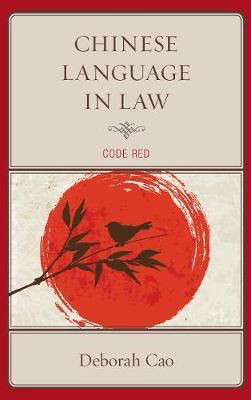
3:16: You’ve suggested that understanding Chinese law and society we need to understand Chinese language and traditions and legal and political context and subtext, as well as be aware of the interaction between legal norms and cultural and linguistic values in their legal realisation. If we look at law from this linguistic and cultural perspective are there resources you detect to support changing the law around animal welfare?
DC: As we know, the Chinese language is unique and complex. It is also very human focused, and to a large extent very male human oriented. Relating to animals, in modern Chinese, we have the pronouns equivalent to the English he, she and it. The Chinese words for these are pronounced exactly the same - ta, but written differently, ?,?,?. In Chinese, we also have the plural forms for they/them, ??tamen (for males), ??tamen (for females), and ??tamen (for inanimate objects). Intraditional classical Chinese, we also have a pronoun ta ?specifically for animals (no English equivalent), but it is no longer used in modern Chinese. In English, ‘it’ is used to refer to animals and inanimate objects, but today in the West, increasingly, ‘he’ and ‘she’ are being used for animals. However, in China, in formal written publications, such as newspapers and books, popular and academic, the inanimate object ta ?is normally used. Just recently I had an argument with a Chinese publisher that published a book I co-edited on farm animal welfare. The publisher insisted that the inanimate object ta ?and tamen ??are used to refer to animals as it is the standard and conventional usage in Chinese publishing. They told me that thepeople ta and tamen if used for animals would be regarded as an error by the Chinese publishing industry. because of my insistence, the publisher eventually relented but they also insisted on a note in the book that this was done for the purpose of raising awareness of animal welfare. They did not want their Chinese publishing counterparts to think that it was not a careless mistake on the part of the publisher. In all my writings in Chinese published in China and online, I always insist on using the people ta and tamen for animals. My other Chinese publishers never objected for my previous Chinese works. I may be one of the first writers in China who use the people ta and tamen for animals in recent years. It is a significant yet subtle matter of perspectives and how we naturally think of animals. In spoken Chinese, it does not matter as the words are indistinguishable, but in Chinese writing, the words carry lots of unspoken weight. So, language and use of language is important in our perceptions and attitude to our animal friends.
3:16: We’ve focused on animal cruelty in China but you observe that animal cruelty is on the rise worldwide too. The cruelty is being globalised. One issue is the relationship between animal welfare science and the law. Do you think law needs to pay greater attention to these scientific studies, and what difference would it make if it did?
DC: Yes, this is particularly relevant in China. Generally speaking, the Chinese, both the general population and the government, have a high regard for science, especially advanced scientific knowledge. Many Chinese today may be more easily convinced of the notion of animal welfare by science than by moral persuasion. After all, animal welfare is a scientific concept, and animal welfare can be assessed using scientific methods, like behavioural or physiological measures or indicators, to tell us the state of the animals. The regulations and laws concerning animal welfare are or should be informed by animal welfare science. In the past few years, I have been working with Chinese farm animal scientists. It is very encouraging that the Chinese government and agricultural scientists are showing interest in farm animal welfare, to improve their welfare. In the past few years, China has developed, mainly by farm animal scientists, and published a set of farm animal welfare requirements, for cattle, pigs, hens, sheep, formulated on the basis of animal welfare science and technology and international standards for farm animals such as those by the RSPCA.
3:16: Is it time for an international law about this issue as it becomes a global issue?
DC: Yes, I would think so. Today, a great deal of violence and crimes against animals may originate in one country, but their impact goes beyond one nation, as in the Chinese case of wildlife crimes and wildlife trafficking, Japanese whaling, and many others. Governments, international animal NGOs, and lawyers can play and are playing a major role in this area. Due to globalization and increased contact between peoples and trade, and universal concerns for animal welfare, there is a need for more international efforts to combat animal crimes in international law as a global issue. It is imperative to establish and strengthen a legal regime in international animal protection, not just for wildlife but other animals as well.
3:16: What changes would you advocate in the attitude towards and conception of wildlife protection – and would you want this to take place irrespective of species and usefulness as a food source, say?
DC: I think all sentient animals deserve protection against human abuse and violence, not just endangered species, or wildlife. All animals deserve our respect as fellow creatures and dwellers of the Earth. They are not people’ food or tools, or resources to be exploited for human benefit. I love the following profound words by Henry Beston, words I cited at the beginning of one of my books:
We need another and a wiser and perhaps a more mystical concept of animals. Remote from universal nature and living by complicated artifice, man in civilization surveys the creature through the glass of his knowledge and sees thereby a feather magnified and the whole image in distortion. We patronize them for their incompleteness, for their tragic fate for having taken form so far below ourselves. And therein do we err. For the animal shall not be measured by man. In a world older and more complete than ours, they move finished and complete, gifted with the extension of the senses we have lost or never attained, living by voices we shall never hear. They are not brethren, they are not underlings: they are other nations, caught with ourselves in the net of life and time, fellow prisoners of the splendourand travail of the earth (Beston, 1929).
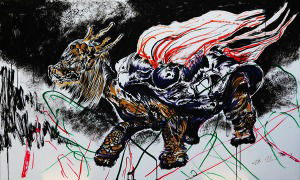
[Art: Sun Xun]
3:16: Why do you think the animals should be seen as legal victims of human harm and that we should expand the definition of crimes against wildlife to include harms done to them both legally and illegally? Doesn’t this risk losing support for change from non-vegetarians, for example, which might mean that incremental change can’t happen which may be the best hope for starting a process of reform?
DC: The basic premise is that acts of cruelty against animals are a moral issue, and some such acts are already deemed acts of criminality and social harms in civilized societies in many jurisdictions around the world. So, naturally, laws, both domestic and international laws, should be used to reduce and redress such wrongs humans do to other animals. Our anthropocentric thinking and attitudes towards animals requires a fundamental shift notwithstanding the progress made for animal protection in the last few decades. Animal crimes and abuse are social harm affecting humans and animals alike and must be taken seriously and tackled as a global and collective concern of humanity. It is a social justice issue, not just human compassion and benevolence. More and more people are recognising this now, and animal welfare and ethics are not the exclusive or esoteric concerns of animal scholars or advocates. A very important and exciting recent development is the research and production of ‘clean meat’, cultured meat grown in the lab from animal cells. I hope we are moving towards a world without slaughter in order to feed ourselves, and in this day and age, we do not need to kill in order to survive. Importantly, this clean meat revolution is driven by ordinary consumers, both vegetarian and non-vegetarian. It may represent a major shift for humanity, not just for the benefit of animals, but also for humans and our sustainable world.
3:16: As we touched on above, you’ve looked at some foundational questions regarding law – its nature and function and in particular the problem of legal interpretation and the construction of meaning within and through law. Can you sketch for us then what a semiotic theory of law is and what are the key questions it throws up, in particular when examining Chinese law?
DC: This is such a big topic. Essentially, law is a system of signs. So is language. Both language and law are semiotic systems, that is, they are complex sign systems that communicate meanings in society. Both involve the exchanges of meanings and construction of meanings. For the Chinese language used in law, it obviously shares commonality with other legal languages. It nevertheless has its own peculiarities, due to social, cultural and historical reasons. For instance, if we compare English and Chinese, legal English is such a long established specialist language that a native English speaker requires a legal education just to understand the legal jargon. In contrast, the language used in Chinese law is very ordinary, almost banal and extraordinarily plain. However, in such plainness, one finds its peculiarities which are just as intriguing and frustrating as one finds in the complexity of the English legal language, because language itself, either Chinese or English, holds many hidden texts and tells endless stories.

3:16: Translation throws up the interesting and tricky question about the relationship between language and law. You’ve written about this – how would you characterise that relationship?
DC: This again is a huge topic. It is generally accepted that language is important and vital to law and the legal process. Law is expressed in language and performs its functions through language. As an American legal scholar, Schauer, once writes, ‘language plays a central role in the operation of law that is different from, even if not necessarily greater than, the role it plays in facilitating many other forms of human interaction.’ So basically, language matters a great deal in law. But language matters not just in relation to law. Language matters in most facets in our life and our existence and in human civilization. The Chinese are particularly aware of this, thanks largely to Confucius who famously said: If names are not correct, language is not in accordance with the truth of things. If language is not in accordance with the truth of things, affairs cannot be carried on to success.
3:16: And finally, for the readers here at 3:16, are there five books you can recommend that would take us further into your philosophical world?
DC: There are many books on animals and animal-human relations these days, with some focusing on animal behaviour, moral and ethical issues how we treat animals, the inherent cruelty associated with factory farming and animal law and rights.
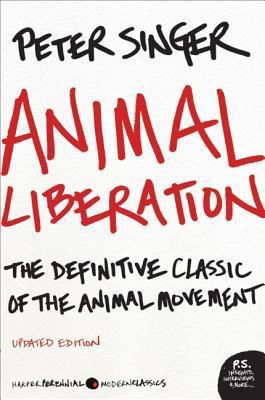
The most important classic is the book by Professor Peter Singer, Animal Liberation, and I am sure most people have read.

Another of his books is also relevant and thought provoking, Practical Ethics.
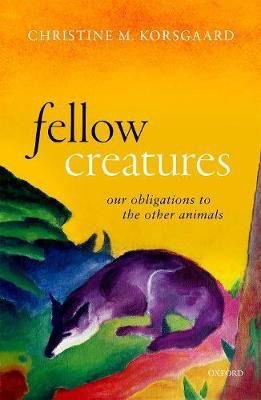
A recently published book Fellow Creatures: our obligations to the other animals, by Christine Korsgaard, is also a must read.

A more general introductory textbook that we use in teaching – The Animal Ethics Reader edited by Susan Armstrong and Richard Botzler, a comprehensive anthology that includes works by some of the most influential writers in animal ethics.

Another significant and fascinating work is The Moral Lives of Animals by Dale Peterson – provides evidence and informs us that animals have rich moral lives, a fact that most people are still oblivious to.

ABOUT THE INTERVIEWER
Richard Marshall is biding his time.
Buy his new book here or his first book here to keep him biding!